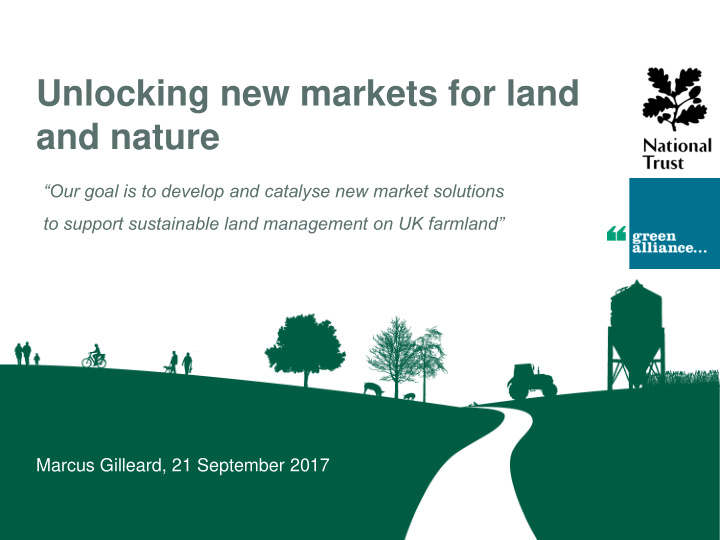



Unlocking new markets for land and nature “Our goal is to develop and catalyse new market solutions to support sustainable land management on UK farmland” Marcus Gilleard, 21 September 2017
Our goals Be a catalyst for change: work collaboratively to solve challenges that no one organisation could fix alone Change the terms of the business, political and regulatory debate on the commercial value of healthy, productive ecosystems and natural capital Demonstrate the practical possibility of viable private markets for enhanced ecosystem services from land
Why? NT wanted to explore how a paradigm shift could be achieved in the way land is managed and supported, by-passing CAP Decided to focus on natural capital, recognising twin benefits of investing in natural assets that underpin food production and opening farming to new funding possibilities - especially relevant for the uplands Increased political and public awareness of the benefits to society of good environmental management at landscape scale Genuine appetite among land-based businesses and their value chains for doing things differently: recognising dependency on natural assets Costs more to cope with degraded natural systems than it costs to restore them Brexit changes everything: public funding will remain critical but the private sector will increasingly need to play its part given its dependency on nature Helping to move the ‘natural capital approach’ from rhetoric to reality: NT land as ‘test - bed’ and Green Alliance building a powerful coalition for change
Our solution: Natural Infrastructure Schemes Market-based mechanism based on private contracts for farmers to improve the ecosystem services generated by their land • Market in avoided costs • Multi-buyer, multi-seller model • Farmer-led • Payments incentivise change • Sells a service based on results • Designed for catchment scale delivery • Stackable benefits / scope as part of post- Brexit funding model
How a NIS would work
How we are approaching it: 7 areas of inquiry Science and practice The NIS land management options 1. Land management and surveyors 2. Hydrology and catchment science Changes to agricultural practices to improve soil and reduce compaction Change of land use not adjacent to rivers e.g. bunds, tree planting Economics, regulation and markets Change of land use adjacent to rivers e.g. treatment wetlands 3. Funding and investment Modifications to drainage infrastructure e.g. blocking pipes 4. Sell-side regulation 5. Legal and contractual Alterations to the course of a river 6. Buy-side regulation Creation of new structures in rivers e.g. woody debris 7. Environmental monitoring and enforcement
Where we plan to get to: our route to market 1. Better define the market potential: characterise catchments where a NIS-style contract should be possible 2. Characterise the business models that could underpin the market, and the outcomes they are likely to lead to 3. Pinpoint the key areas of risk and negotiation for buyers and sellers, and how the contract should look to address them 4. Identify actions for government, regulators and business to facilitate the emergence of this market
Which sites? Extent of local water issues: flood / drought / water quality Existing land use and quality in a catchment Current status of local biodiversity and ecosystems [potential for significant co-benefits] Flood risk profile for properties [current and future] Land area in the catchment Land ownership and management structure: numbers of owners, size and location of holdings, prevalence of tenants, common rights holders etc. Area within the catchment subject to land use restrictions: participation in AES, covenants etc. Presence of significant infrastructure at risk from flooding Proximity / connectivity of land to infrastructure and / or local population centres Scale of known planned flood resilience spending Coverage of existing flood defences within the catchment Catchment classification based on the catchment hierarchy Flood risk for rivers / water bodies under defined rainfall events Engagement of local political figures (MPs, local authority leaders) with flooding Economic Geo-physical potential potential Catchment Local flood and land or water NIS use quality mitigation costs options
Latest report: route to commericalisaton Identifies three conditions to be met • Technically viable water attenuation projects • Provable cost savings for private organisations that would otherwise be exposed to high costs from flooding • Development of a robust commercial framework including contract and payment terms Explores economic viability based on thought experiment in the North-West (a region that will be particularly hit post-Brexit)
What can government do? • Use smart regulation to remove barriers and encourage behaviour change • Improve local planning and procurement of flood risk mitigation • Provide research funding to increase knowledge and reduce costs, including agri-environment seed-funding during post-CAP transition • Introduce quantifiable long-term objectives for environmental restoration And for participants: collaborate on example projects to overcome cultural barriers and identify the right locations for schemes
More generally? • Explore synergies with future agri-environment schemes and a complementary approach to environmental efficiency, enabling food businesses to maintain the natural assets they depend on, and protect themselves from increased costs • Develop a better understanding of the quality and extent of natural infrastructure assets, as well as capital and maintenance spending needed • Develop an investment programme and catchment-based approach to inform and direct where public payments should be invested and new markets created for greatest benefit
Taking this work forward: four areas Test and prove the Natural Infrastructure Scheme concept Build a Leadership Group of landowners, water companies and others to champion and facilitate natural markets Continue to develop innovative and challenging ideas for natural markets (e.g. soil carbon, tourism, health) Engage with government and stakeholders to shape policy and build partnerships
Thank you For more information marcus.gilleard@nationaltrust.org.uk or wandrewstipper@green-alliance.org.uk
Recommend
More recommend